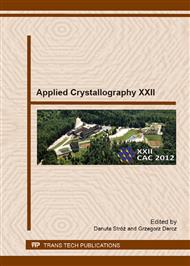p.390
p.394
p.398
p.402
p.406
p.411
p.417
p.423
p.427
Influence of the Crystallographic Orientation of CuZn30 Single Crystal on the Portevin-Le Chatelier Effect
Abstract:
Plastic deformation of solid crystals is a complex process, mostly heterogeneous, due to the simultaneous effect of several deformation mechanisms. A dominating deformation mechanism depends on the properties of the material and external coefficients, viz. temperature, stress and strain rate. The applied Bridgman method permitted to obtain single crystal of the CuZn30 alloy adequate for plastic deformation investigations. Single crystal are characterized by selected crystallographic orientations from various areas of the basic triangle. In order to determine the influence of the crystallographic orientation on the Portevin-Le Chatelier effect selected single crystals were compressed at a temperature of 300°C at a strain rate of 10-3 s-1. Experiments confirmed the effect of the crystallographic orientation axis of CuZn30 single crystals on the observed differences in the intensity of stress oscillation on stress-strain curves.
Info:
Periodical:
Pages:
406-410
Citation:
Online since:
June 2013
Price:
Сopyright:
© 2013 Trans Tech Publications Ltd. All Rights Reserved
Share:
Citation:


